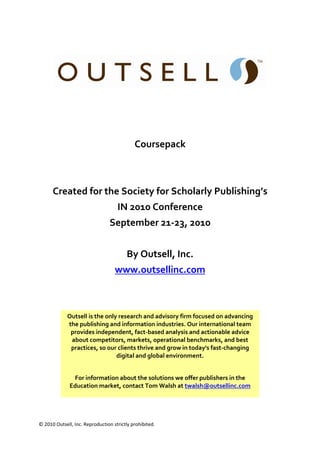
Promethean Puts Personalised Learning Back On The Agenda
- 1. Coursepack Created for the Society for Scholarly Publishing’s IN 2010 Conference September 21‐23, 2010 By Outsell, Inc. www.outsellinc.com Outsell is the only research and advisory firm focused on advancing the publishing and information industries. Our international team provides independent, fact‐based analysis and actionable advice about competitors, markets, operational benchmarks, and best practices, so our clients thrive and grow in today's fast‐changing digital and global environment. For information about the solutions we offer publishers in the Education market, contact Tom Walsh at twalsh@outsellinc.com © 2010 Outsell, Inc. Reproduction strictly prohibited.
- 16. Horizon Report Makes Its Predictions for 2010 By Kate Worlock, May 7, 2010 This year’s Horizon Report suggests that mobile delivery of educational content and services will be a key near‐term trend to watch. Important Details: The 2010 Horizon Report is the seventh in an annual series produced by the New Media Consortium and the EDUCAUSE Learning Initiative. The report is based on the work of the New Media Consortium’s Horizon Project, a qualitative research project established in 2002 that identifies and describes emerging technologies likely to have a large impact on teaching, learning, or creative inquiry on college and university campuses within the next five years. Each report describes six emerging technologies or practices which are likely to enter mainstream use within this period. The emerging technologies or practices covered in this year’s report, and the timeframes in which they are expected to move into the mainstream, are: • Mobile computing (near term ‐ within the next 12 months); • Open content (near term ‐ within the next 12 months); • E‐books (medium term ‐ two or three years away); • Simple augmented reality (medium term ‐ two or three years away); • Gesture‐based computing (longer term ‐ four or five years away); • Visual data analysis (longer term ‐ four or five years away). Implications: Mobile computing was highlighted as a near‐term trend to watch in the 2009 Horizon report as well. The report, which outlines a handful of the hundreds of mobile computing projects at higher education institutions in the US, suggests that mobile devices are increasingly the platform of choice given that they are much cheaper than desktop or laptop computers. However, what the report does not mention is the challenge for educational service providers of developing offerings for a very broad range of mobile devices. Little change, other than an increase in the amount of experimentation with mobile services, seems to have taken place between the two Horizon reports, and it seems likely that until better mobile delivery standards are available, experimentation rather than mainstream take‐up will continue to be the name of the game. The Horizon report remains well worth watching, since some of its previous predictions have been very good. In the 2008 report mobile broadband was highlighted as a developing trend in the two‐ three year timeframe, and this has certainly been the case. The report has also highlighted cloud computing in the past, and indeed the use of services like Google Docs in educational settings has been worth noting. In addition to the list above, Outsell would suggest that the following trends would also be worth considering: • Customisation: increasingly, faculty members are able to refine publishers’ offerings to suit their own courses, and in rare cases such as Dynamic Books (see Insights 8 March 2010, Macmillan Allows Users To Dissect The Textbook) can even amend textbooks at sentence level. • DIY services: faculty are starting to create their own content, which is not necessarily being made available as open educational resources, but as revenue‐generating offerings. A recent example here includes the 20 textbooks developed at Florida State College at Jacksonville. © 2010 Outsell, Inc. Reproduction strictly prohibited.
- 17. • Whole service offerings: While the Horizon report predicts the emergence of e‐books into the mainstream over the next two‐three years, it seems increasingly likely that this trend may be overtaken by the development of whole course offerings such as WileyPlus or Pearson MyLab which go far beyond what the textbook can deliver, whether in a print or electronic format. Contact Outsell, Inc. Call +1 650.342.6060 Fax +1 650.342.7135 330 Primrose Road, Suite 510 Burlingame, California 94010 Call +1 617.497.9443 Fax +1 617.497.5256 763 Massachusetts Avenue Cambridge, Massachusetts 02139 Call +44 (0)20 8090 6590 Fax +44 (0)20 7031 8101 25 Floral Street, London, WC2E 9DS info@outsellinc.com www.outsellinc.com The information, analysis, and opinions (the “Content”) contained herein are based on the qualitative and quantitative research methods of Outsell, Inc. and its staff’s extensive professional expertise in the industry. Outsell has used its best efforts and judgment in the compilation and presentation of the Content and to ensure to the best of its ability that the Content is accurate as of the date published. However, the industry information covered by this report is subject to rapid change. Outsell makes no representations or warranties, express or implied, concerning or relating to the accuracy of the Content in this report and Outsell assumes no liability related to claims concerning the Content of this report. © 2010 Outsell, Inc. Reproduction strictly prohibited.